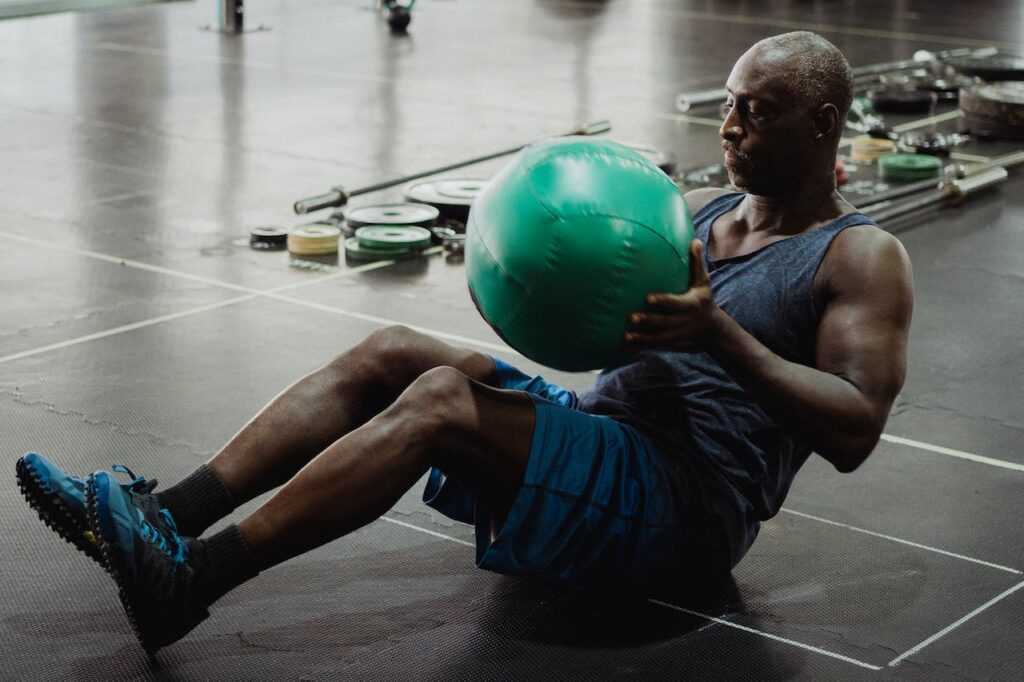The muscles in the core are in charge of maintaining the spine’s stability, balancing the body, enabling functional movement, and reducing low back discomfort . You can see them as the mainframe that regulates your movement because they are situated in the middle of your trunk. To strengthen your core and invigorate your body, attempt these 12 ab exercises right now.
Crunches are not the best approach to improve your core, despite what the glossy fitness publications would have you believe. It’s crucial to realise that doing solo abdominal exercises won’t strengthen your core. Actually, the secret to having a strong core is to tone every muscle in your body, including the ones in your back, butt, stomach, chest, and upper thighs, from your sternum to your pubic bone.
The secret to core stabilisation is to learn how to “hug” your back and abdominal muscles towards your spine, contract your pelvic floor, and breathe deliberately. You’ll learn how to do this in four essential positions with the 12 ab exercises you’ll master today: supine (lying on your back), prone (lying on your stomach), side, and all fours. It will be more difficult for your core muscles to hold you the less contact you have with the ground; for this reason, a full plank is a lot harder workout than supine marching.
As you’ll see below, once you’ve strengthened your core in a comparatively static posture, you may safely raise the difficulty and intensity of your motions without sacrificing your stability.
But first, a quick rundown of the four main core muscles before we get started with the exercise. The transversus abdominis, multifidi, pelvic floor, and internal/external obliques’ capacity to coordinate and co-activate when necessary is essential to a healthy core.
Transversus Abdominis (TA) is the first core muscle.
These muscles, which are located in the deep low abdomen, are the most crucial abdominal muscles for enhancing posture and supporting the spine.
Multifidi (MF) is the second core muscle.
Along with the other core muscles, this deep muscle runs along the back of the spine and helps to stabilise the low back and pelvis before moving the arms or legs.
Pelvic Floor (PF): Core Muscle #3
The muscles that make up the pelvic floor stabilise the pelvic girdle, support the internal organs, and help to build stronger abdominal muscles . (They’re also an important muscle to know when you’re stopped in traffic and need to use the restroom!)
Internal Oblique (IO) Muscle #4:
The internal and external obliques are the two distinct muscles that make up the oblique abdominals. They function to support the abdominal wall, compress the abdominal cavity, twist the trunk and flex the spine from side-to-side. Above TA and below the external oblique is where the internal oblique is located.
After you have a mental image of the muscles you will be using, let’s practise 12 of the greatest abdominal exercises for core stability. Start at the beginning of this programme and continue to the higher level when you feel ready.
12 Core-Stabilizing Ab Exercises
Which of the four previously discussed core muscles will contract most during each exercise is indicated by the letters below.

Marching (TA, PF)
With your feet flat on the floor and your spine in neutral position (a slight bend in the low back and a flat pelvis), lie on your back. Breathe in to get the body ready. Let out a breath, pull your belly button gently towards your lower back to engage TA, and raise your right leg to a 90-degree angle above your hip bone. Breathe in, then softly put your foot back down. Breathe out and raise your left knee. Take a breath, set it down again. For ten repetitions on each leg, keep switching. Throughout this exercise, DO NOT MOVE your pelvis or spine; instead, maintain a flat abdominal wall.
Dead Bug (TA, IO, MF)
Lying on your back, raise both legs to 90 degrees so they are directly above your hips, keeping your spine in neutral. Raise your arms vertically towards the sky, keeping your wrists over your shoulders. Sigh in to get ready. Breathe out, reach back with your left arm and straighten your right leg without moving your torso. Take a breath and come back to the beginning. Breathe out, stretch back with your right arm, and extend your left leg forwards. Take a breath and come back to the beginning. For ten reps on each side, keep switching. Throughout this exercise, DO NOT MOVE your pelvis or spine; instead, maintain a flat abdominal wall. To adjust: stop wriggling the arms.
The Hundred (TA, MF, PF, IO)
Lay flat on your back with your arms at your sides, both legs raised to a 90-degree angle directly over your hips, and your spine in neutral. Breathe in to get the body ready. After letting out a breath, raise your head and chest into an upper abdominal curl while keeping your hands a few inches off the ground. As you raise and lower your arms, inhale for five counts, then release the breath for five counts. Do 5–10 rounds in total before taking a break. Once the exercise begins, DO NOT MOVE OTHER THAN YOUR ARMS. Lower your head to alter.
Bridge Marching (MF, IO)
Lay flat on your back with your arms by your sides, feet parallel, hips pressed up against the ceiling, and spine flat. Breathe in to get the body ready. After exhaling, softly tighten your lower abdomen and narrow your rib cage, engage TA by pulling your belly button towards your low back, and raise your right leg to a 90-degree angle. Breathe in, then put your right foot back down. Lean the left knee to ninety degrees, exhale, and contract your core again. Take a breath out and put your left foot back. Work through 10 reps in total, 5 on each leg. As you move the legs, keep the pelvis solid, the spine long, and the abdominal wall flat.
Single Leg Stretch (IO, MF)
Lying on your back, raise both legs to 90 degrees so they are directly above your hips, keeping your spine in neutral. Breathe in to get the body ready. Let out a breath, raise your head and chest into an upper abdominal curl, and extend your left leg away while reaching your hands to your right knee. Draw in, hold. Let out a breath, turn around, and extend your right leg while gripping your left knee. Draw in, hold. For a total of 10 repetitions, 5 on each leg, alternate. Just move the legs while maintaining full stillness in the head, chest, spine, and pelvis.
Prone Leg Lifts (MF)
With your legs pushed back against the floor and your head supported by your hands, lie on your stomach. Inhale, get ready. After releasing the breath, raise your right leg to hover just a few inches off the ground. Draw in, release. Blowing out, raise your left leg to hover. Draw in, release. Repeat alternating for a total of 20 times, ten on each leg. When you move your legs, DO NOT ROCK your whole weight back and forth.
Clam (MF, IO)
Place your head down on your lower arm while lying on your side. With the heels aligned with the sit bones, both knees are stacked and bent. Exhale to twist the top knee towards the sky and turn the top inner thigh forwards while maintaining a perfectly motionless pelvis. Breathe in and bring the knee back down. Before switching to the other leg, perform ten to fifteen reps on this one. Move only your upper leg and thigh; you should feel a slight activation in your outer hip, lower back, and waist.
Spinal Balance (TA, MF, IO)
With the knees beneath the hips and the wrists under the shoulders, begin on all fours. Maintaining a long, neutral spine, slowly move your belly button towards your low back to engage TA. Maintain this position for the remainder of the exercise. Take a breath out, raise your left arm, and stretch your right leg back. Breathe in and droop your arms. Let out a breath, throw your left leg back, and raise your right arm. Breathe in and droop your arms. For a total of 10 repetitions—5 on each side—keep alternating. Throughout this workout, DO NOT MOVE your shoulders, hips, or waist.
TA, MF, PF, IO Knee Hovers
With the knees beneath the hips and the wrists under the shoulders, begin on all fours. Put your toes in. Inhale, get ready. After exhaling, activate TA by bringing your belly button softly towards your low back while maintaining a neutral, long spine. Then, float your knees one inch off the floor without bending your spine. Draw in, hold. Exhale and bend your knees. Do this five to ten times more.
Plank Retraction Steps (TA, MF)
With the knees beneath the hips and the wrists under the shoulders, begin on all fours. Maintaining a long, neutral spine, slowly move your belly button towards your low back to engage TA. Maintain this position for the remainder of the exercise. You are now in the full plank position. Inhale, step the right leg back, and tuck your toes under. Exhale, step the left leg back, and do the same. Breathe in, bringing the right knee back down; release the breath, bringing the left knee down. Perform five reps with the right leg first and five with the left leg first. Throughout this workout, DO NOT MOVE your shoulders, hips, or waist.
Lifting Plank Legs (MF, TA)
Start in plank position, with the wrists under the shoulders and feet hip-width distance apart. Inhale, prepare. Exhale, float the right foot up and away from the floor without moving the pelvis. Inhale, place it back down. Exhale, float the left foot up. Inhale, place it back down. Continue to alternate for a total of 10-20 repetitions. Note: the core remains engaged throughout this entire exercise!
Side Plank Hip Lifts (modified and full) (IO, MF)
With your right hip and forearm on the ground and your legs either bent (modified) or straight (advanced), begin on your right side. Breathe out, tighten your waist to activate your obliques, then raise your hip off the ground. Take a breath, tap your hips. Exhale and raise your hips. After six to twelve repetitions, switch sides.


